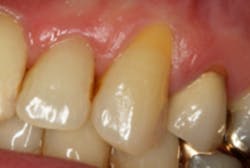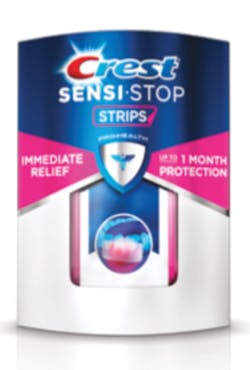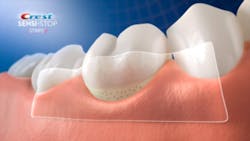An innovative way to relieve dentinal hypersensitivity
A new technology may revolutionize the way hypersensitivity is managed
BY Sarah M. Burt, RDH, MDH, and Shelly L. Campbell, RDH, MPH
QuickQuiz
Which patient scenario is of most concern?
(A) A man with a constantly aching and significantly decayed molar, or
(B) A woman with some bilateral buccal premolar recession who has shooting pain when she sips iced tea?
Most clinicians would correctly select (A), since dental caries needs prompt treatment to reduce pain and avoid more extensive treatment. Patients would likely agree, and no doubt, when it comes to the agony of a caries- or perio-induced throbbing toothache, even those who have a long-standing tradition of avoiding dentistry may race to a dentist, desperate for relief.
While less critical, choice (B) - recession with transient pain upon cold stimulus - can have a significant impact on patients' oral health and quality of life. When recession exposes dentin, leading to the pain and discomfort known as dentinal hypersensitivity, some sufferers will delay or completely avoid professional care, concerned that the examination or treatment procedures will be too uncomfortable. Memories of misery from the rush of syringe air, icy cold water, and zapping sensations from an explorer tip or scaler bring anxiety. The dread of the sharp pain elicited through basic evaluation techniques may be enough to cause these patients to not only forgo a visit for their hypersensitivity, but to also skip vital routine examinations and prophylaxes that would uncover other conditions requiring attention. Early, treatable problems get ignored, leading to bigger, more costly, and invasive fixes. Yet the path to successful treatment of dentinal hypersensitivity is not always clear-cut, often leading to frustration on the part of patients who want quick relief, and dental clinicians who want to offer practical yet effective treatment.
Is this a minor issue impacting a small number of any given practice's patients? Surprisingly, the answer is no. Various surveys from around the globe have estimated that as many as 30% to 57% of adults evaluated had a lifetime incidence of dentinal hypersensitivity, with females being somewhat more likely to be affected.1-3 Patients with periodontal disease have the highest incidence.4,5
Research measuring the impact of oral health on one's quality of life has shown that dentinal hypersensitivity sufferers rate their quality of life lower.6,7 Daily living activities taken for granted by others without hypersensitivity can be impaired - the pleasure of eating foods such as ice cream, the ability to thoroughly brush teeth, taking a deep breath, and even social functioning can all be negatively affected when this frustrating problem is left untreated.
What exactly is dentinal hypersensitivity?
Your patients would probably say, "I have sensitive teeth." Dentinal hypersensitivity means a hyper, or exaggerated, response to stimuli that would not normally produce discomfort, and it can't be attributed to another condition such as a cracked tooth.8 For sufferers, this means there are areas, most commonly the facial cervical surfaces of canines and premolars, where sudden, sharp flashes of pain are provoked by exposures that fall into a few broad categories. Tactile sensitivity means pain resulting from mechanical contact with an object, such as toothbrushing or scraping with a fingernail. Thermal sensitivity typically occurs when a cold (or sometimes hot) food, drink, or air source hits the affected area. Some sufferers also have chemical or osmotic triggers that set off uncomfortable sensations, like carbonated beverages or sugar.
Whatever a patient's sources of pain generation, the root cause of dentinal hypersensitivity originates from exposed dentinal tubules. Factors leading to exposed dentin include periodontal disease, dental erosion, or improper or overly aggressive oral hygiene practices like toothbrushing.9 Dentinal hypersensitivity sufferers have been shown to have a greater number of, and wider open tubules within the dentin.10 Human dentinal tubules are as tiny as 2.42 microns in diameter, and packed as densely as 15,385 per square millimeter in superficial dentin, so even a very small area of dentin denudation can expose a huge quantity of open tubules.11 A majority of researchers believe tactile, thermal, or chemical/osmotic triggers stimulate the rapid movement of fluid within the exposed tubules, which excites nerve receptors and results in the characteristic sharp, shooting, or stabbing pain sensation of dentinal hypersensitivity.12
They may not realize it, but patients with dentinal hypersensitivity don't have to resign themselves to living with the problem. The most common first-line treatment for reducing pain is over-the-counter potassium nitrate dentifrice, which aims to desensitize the teeth by reducing nerve excitability.13-15 There are limitations to this approach, however, including slow onset of relief, the need for regular daily use to maintain relief, and the lack of targeted delivery to the site of sensitivity. Desensitizing treatments can also be applied professionally during an office visit, and options include resins or high-concentration fluoride varnishes with the goal of physically blocking or "occluding" the open dentinal tubules. Patients may even opt for invasive procedures such as dental restorations, lasers, or gingival grafting. What has not been available to patients over-the-counter until recently is a desensitizing product that combines ease of use, ready and affordable access, and swift, clear-cut performance while acting on the precise sites of pain.
What's new in dentinal hypersensitivity management?
A recent and exciting advance in the field of dentinal hypersensitivity management uses a site-targeted delivery vehicle to give patients a convenient but powerful choice to stop the pain of hypersensitive dentin. Crest Sensi-Stop Strips (Procter & Gamble, Cincinnati, OH) are a highly innovative, patented strip technology layered with an oxalate-containing gel, shown to provide immediate relief from hypersensitivity pain after a single use. These unique, noninvasive desensitizing strips give patients a revolutionary way to custom-focus treatment to their problem areas. Patients will also likely appreciate being able to purchase Crest Sensi-Stop Strips at their favorite health and beauty outlets and use them in the comfort of their homes, or wherever sensitivity pain may strike.
Crest Sensi-Stop Strips are the first product to combine the innovation of strip technology - thin and flexible strips that conform and adhere to the gingival and tooth surface - with an oxalate-containing gel, clinically proven to stop the pain of dentinal hypersensitivity.16 Like hitting a target with an arrow, Crest Sensi-Stop Strips are applied to the exact location of exposed dentinal pain for maximum effectiveness, occluding the dentinal tubules with oxalate crystals to stop discomfort. Research shows one strip applied for 10 minutes brings immediate relief that lasts for up to one month.16
Central to the quick-acting effectiveness of Crest Sensi-Stop Strips is the key ingredient oxalate, which is kept in constant direct contact with the pinpointed hypersensitive site during the 10-minute treatment. Oxalate has been incorporated in dentinal hypersensitivity treatments17 because of the known ability of oxalate crystals to provide occlusion of open dentinal tubules left exposed by the loss of enamel or cementum.18 This oxalate-based physical blockage shuts down tubule fluid flow, which in turn cuts off the nerve overstimulation that is at the root of the sharp pain. Using this key ingredient in the strip delivery system provides a unique sensitivity treatment that delivers immediate and durable relief.
Imagine this scenario: While out on an errand you run into Mrs. Jones, your on-again, off-again patient of five years who has worsening gingivitis. (Remember Patient B from the opening quiz?) She sheepishly admits that she knows she's way overdue for her exam and prophylaxis, but she cringes at the thought of your scalers and cold water on her lower left premolars. What if you could offer a solution to ease her concerns, one that could proactively and noninvasively target her discomfort with the simple placement of a strip, in just 10 minutes?
Crest Sensi-Stop Strips are a potential practice builder, drawing in both established and new patient dentinal hypersensitivity sufferers looking for pain relief or a means of making in-office care more comfortable and less stressful. Some ways to use Sensi-Stop Strips in the office practice might include:
• Pre-procedural application - at home. Patients who have already purchased Crest Sensi-Stop Strips can be instructed before their appointments to place strips according to package label directions on any sites of identified dentinal hypersensitivity before coming in for a prophylaxis or other procedure where anesthetic use isn't planned.
• Pre-procedural application - in office. The patient is advised to come in about 30 minutes before the procedure time, and a strip(s) is applied to areas known to be painful upon stimuli due to exposed dentin. To prevent tying up operatory space, the patient can sit comfortably in the waiting area. In 10 minutes, before procedure time, pain relief will be in effect.
• Clinician modeling followed by at-home use. The clinician can provide helpful tips to patients in correctly positioning and placing the strip(s) on one or more sensitive sites while the patient watches in a mirror. The patient is then counseled on using additional strips at home as needed. Additional instructions about modifying habits that may be contributing to hypersensitivity can be given at this time (e.g., reducing consumption of acidic beverages and/or avoiding aggressive oral hygiene). Since patients with dentinal hypersensitivity may have periodontal issues, recommending a dentifrice that improves plaque control and gingival health may be a beneficial adjunct to Sensi-Stop Strips home-care desensitizing treatment.
Learning to use Crest Sensi-Stop Strips to treat dentinal hypersensitivity is straightforward and easy. Designed for facial surfaces, where the bulk of hypersensitivity occurs, one Crest Sensi-Stop Strip can be applied to any sensitive facial site in the anterior or posterior dentition each day. If there is more than one hypersensitive area (frequently the case), the patient can use up to six Sensi-Stop Strips each day to cover multiple painful sites. Sensi-Stop Strips are applied half on the gingiva and half on the affected tooth surface. In as few as 10 minutes, the patient will experience much-welcomed pain relief. Additional strips applied to the same site (one strip per day) can provide even further relief to most people. The ease of use of Crest Sensi-Stop Strips is likely to promote patient compliance, which can then lead to other advantages such as improved oral hygiene in the affected areas. As an added bonus, Sensi-Stop users should find future dental appointments much more tolerable, possibly leading to less stress not only for the patient, but also for clinicians striving to promote a comfortable experience while providing thorough and effective care.
Unmanaged dentinal hypersensitivity is undeniably discouraging for patients who are tired of just "dealing with it." Hypersensitivity sufferers need treatment options, but will typically favor solutions that are easy to come by, not hard to use, not painful, messy, or bad-tasting, and not slow to act or only marginally effective. Crest Sensi-Stop Strips make the grade on all counts, and give these patients a way to relieve their hypersensitivity. Reasonably priced and widely available, Sensi-Stop Strips offer straightforward, painless application, short treatment times, and fast pain reduction results with one strip in as little as 10 minutes for up to one month, making them a win-win for both patients and their oral health-care providers. RDH
Sarah M. Burt, RDH, MDH, has been practicing dental hygiene for over 10 years and currently manages a multilocation dental practice near the Twin Cities. She does consulting work for Procter & Gamble.
Shelly L. Campbell, RDH, MPH, Teneriffe Research Associates, has been involved in the oral health clinical research field for 25 years. She writes from her home near Kansas City, and periodically does medical writing for Procter & Gamble.
References
1. Ye W, Feng XP, Li R. The prevalence of dentine hypersensitivity in Chinese adults. J Oral Rehabil 2012;39(3):182-187.
2. Irwin CR, McCusker P. Prevalence of dentine hypersensitivity in a general dental population. J Dent Assoc 1997;43(1):7-9.
3. Addy M. Dentine hypersensitivity: definition, prevalence distribution and aetiology. In: Addy M, Embery G, Edgar WM, Orchardson R, eds. Tooth wear and sensitivity: Clinical advances in restorative dentistry. London: Martin Dunitz; 2000:239-242.
4. Chabanski MB, Gillam DG, Bulman JS, Newman HN. Clinical evaluation of cervical dentine sensitivity in a population of patients referred to a specialist periodontology department: a pilot study. J Oral Rehabi 1997;24(9):666-672.
5. von Troil B, Needleman I, Sanz M. A systematic review of the prevalence of root sensitivity following periodontal therapy. J Clin Periodontol 2002;29 (suppl) 3:173-177.
6. Bekes K, John MT, Schaller HG, Hirsch C. Oral health-related quality of life in patients seeking care for dentin hypersensitivity. J Oral Rehabil 2009;36(1):45-51.
7. Bekes K, Hirsch C. What is known about the influence of dentine hypersensitivity on oral health-related qualify of life? Clin Oral Investig 2013;17 (Suppl 1):S45-51.
8. Orchardson R, Collins WJ. Clinical features of hypersensitive teeth. Br Dent J 1987;162:253-256.
9. Walters PA. Dentinal hypersensitivity: a review. J Contemp Dent Pract 2005;2:107-117.
10. Absi EG, Addy M, Adams D. Dentine hypersensitivity: A study of the patency of dentinal tubules in sensitive and non-sensitive cervical dentine. J Clin Periodontol 1987;14:280-284.
11. Lopes MB, Sinhoreti MA, Gonini Junior A, Consani S, McCabe JF. Comparative study of tubular diameter and quantity for human and bovine dentin at different depths. Braz Dent J 2009;20:279-283.
12. Brännström M. A hydrodynamic mechanism in the transmission of pain-producing stimuli through dentine. In: Anderson DJ, ed. Sensory mechanisms in dentine: Proceedings of a symposium, London, September 24th, 1962. Oxford, England: Pergamon; 1963:73-79.
13. Silverman G. The sensitivity reducing effect of brushing with a potassium nitrate-sodium monofluorophosphate dentifrice. Compend Contin Educ Dent 1985;6(2):z131-3.
14. Nagata T, Ishida H, Shinohara H, et al. Clinical evaluation of a potassium nitrate dentifrice for the treatment of dentinal hypersensitivity. J Clin Peridontol 1994;21 (3):217-221.
15. Poulsen S, Errboe M, Hovgaard O, et al. Potassium nitrate toothpaste for dentine hypersensitivity. (Review). The Cochrane Collaboration 2004, Issue 4, Wiley Publisher. 1-11.
16. Data on file, Procter & Gamble.
17. Mantzourani M, Sharma D. Dentine sensitivity: past, present and future. J Dent 2013 41 Suppl 4:S3017.
18. Pashley DH. Dentin permeability, dentin sensitivity and treatment through tubule occlusion. J Endod 1986;12:465-474.



